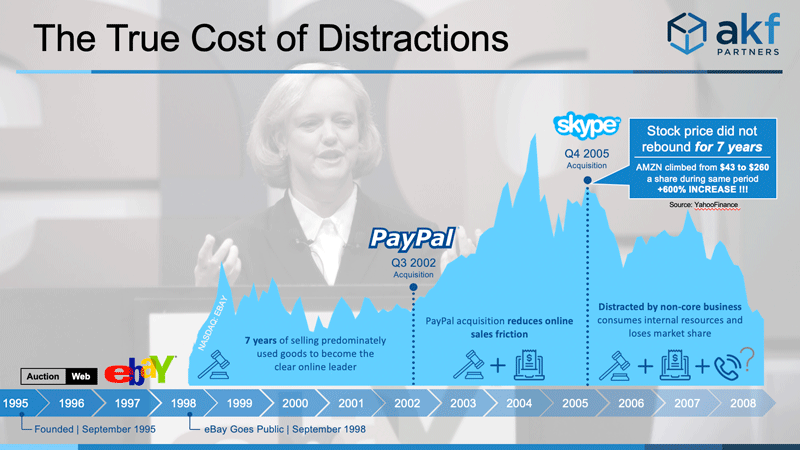The Crippling Cost of Distractions

Perhaps the biggest thief of progress is the misuse of time. Not talking about laziness here – I’m referring to what we often see with our clients – losing focus on what matters most.
Young startups are able to accomplish great things in a very short amount of time because there is rarely anything else to distract them from achieving success and everyone is focused on a shared outcome. Any money they have will likely be quickly exhausted. So food, sleep, vacations, and a life are all put on hold - or at least on the back burner - until products are built, tested, released, and adopted.
As a corporate survivor of 18 years at eBay, I’ve seen a few common themes within my own experience that are also exhibited at other companies where I’ve been involved in the Technical Due Diligence, three day technical architectural workshops, and longer term engagements where I’ve been embedded one of several technical resources. These distractions include:
- Acquisitions
- Supporting legacy applications at the cost of new innovation
Acquisitions
Often M&A teams are highly focused on the short term – what can be accomplished this year or this quarter.
I’ve been involved in many due diligence activities as an internal consultant and as a third-party conducting an external technical due diligence. There is a lot of pressure on the M&A team to sell the deal, and in my experience I’ve seen the positives inflated and the negatives – well, negated, to get the deal done.
Often the full impact on the day-to-day operations team is either not considered or underplayed – if not optimistically overvalued as to how much work can get done in a week realistically over time.
Acquisition Distractions Development is Required to Resolve:
- Integration of Delivery (How to ship, security requirements, etc.)
- Process (Agile vs. Waterfall, what flavor of Agile, etc.)
- Product (Sharing of technologies and features)
An older example, but one that has renewed relevance with the recent focus of another activist investor is the story of eBay’s acquisition of Skype in Q4 of 2005. For shared resources within eBay, this was a huge distraction of already overly leveraged operations teams having to take on additional tasks. The distraction from eBay’s core mission was the true tragedy as it lost focus and opened a window for Amazon to grow 600% over the next 7 years (during one of the worst markets since the Great Depression) while eBay struggled to rebound its’ stock price. When eBay reemerged, Amazon had become a market leader in online commerce and has since pulled significantly ahead in many additional markets.

In our technical due diligences and three day architectural workshops, we can see how companies who were once lean and mean become quickly overwhelmed and distracted from innovation by trying to integrate a flood of acquisitions.
At winning companies, we see that M&A teams carefully evaluate:
- If acquisition will bring immediate ROI (PayPal immediately impacted eBay’s stock price positively and was able to sustain for several years, where Skype did the opposite)
- How much effort integrating the acquisition will require and build enough resources in the acquisition cost to accomplish a speedy induction
- How well the two companies’ cultures meld together
From an internal perspective in my time at eBay, the value Skype would bring wasn’t apparent, and externally most analysts were similarly scratching their heads. For Amazon, it was a godsend as it gave them an opportunity to bear down and focus and take a lot of market share from a sleeping and distracted giant.
Supporting Legacy Applications at the Cost of New Innovation
Legacy applications will keep every business from certain opportunities. We have seen multiple times where a company who was once a leader and innovator became too sales-focused and started squeezing out every last ounce of profitability from their legacy products. As a result, a large % of top developers were focused on building out new features into a declining market allowing a window of opportunity for new startups and competition to edge in.
Top of mind examples are Workday’s stealing of market share from SAP before they purchased Success Factors, or Apple’s edging into PC sales as they created a larger ecosystem of phones, tablets, laptops, TV boxes, etc.
Google is one of the best examples of being willing to dump legacy products - even successful ones - if they see support and maintenance as not keeping up with ROI or cutting into areas where they can innovate faster (Froogle, and Google+ and their capping of support of Chromebooks and Pixel phones at 5 years).
Reasons to sunset legacy products in favor of focusing efforts on developing the “next big thing:”
- Rising Maintenance and Talent Costs – Cost and scope creep happen suddenly and often are much greater than companies are willing to measure or to admit. One of the more informative questions we always ask is: “if you were to build a new product, what would it look like?” or “if you were to go out to market today, would you develop a new product the same way?” The answers are usually very revealing and conclusive - the legacy products have run their course.
- Longer Term Profitability – It takes a bold move to suspend the current cash cow in favor of focusing “all hands on deck” to develop the next big idea and future cash cow. Even when the potential future could be a 3, 4, or 5X revenue generator, companies get short-sighted and are only focused on this quarter’s revenue.
- Lost Opportunity Cost – Put aside your current quarterly projections for sales of legacy products, what is your current and potential competition building today that could greatly diminish your company in just a few years?
Conclusions
To compete with young, well-funded and high octane startups, legacy companies need to create a labs environment to attract top developers and free them from daily distractions of supporting legacy software to remain focused on emerging products and markets.
To succeed, teams must be focused on the highest possible ROI.
- Ensure acquisitions have been properly evaluated for the amount of time and energy it will take to integrate their products and that the cultures of your company and that being acquired are compatible.
- Supporting legacy applications is important for ongoing profitability, but likely can also be done by teams with less experience and expertise. What is often not factored properly is the opportunity cost of keeping legacy products in play long past their shelf life.
- Keep your A-teams focused on new product development, not on keeping the lights on. Create a separate Labs organization and treat them like a startup, and free them from legacy decisions on infrastructure, coding languages, etc. Your competition is starting with a fresh slate, you should too.
We’ve helped many startups and Fortune 500 companies make the transition from legacy software and hardware to SaaS and cloud infrastructure to increase scalability while providing high availability. Let us help your organization!